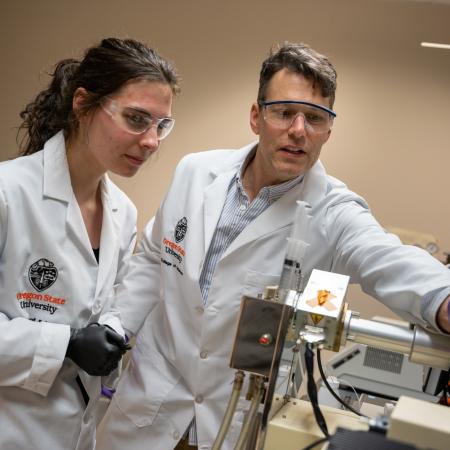The mysteries of human health and disease are as numerous as they are elusive. They pose complex problems that demand complex solutions. As science becomes increasingly interdisciplinary, the edges blurring and blending faster than we can name those evolutions, the challenges of human health require that we examine them from multiple perspectives, from biohealth, bioinformatics and biochemistry to chemistry, mathematics and biology.
In the 21st century, human health and disease require that we as scientists working in the life, physical and mathematical sciences collaborate. That we put our heads together, step outside the traditional academic boundaries to ignite new thinking and spur innovative solutions to address the most pressing problems in human health.
The proliferation of data is transforming the scientific landscape. Scientists are grappling with how to analyze and integrate data quickly across disciplines. With the mounting need for better, faster ways to harness vast amounts of information, mathematical and statistical researchers make for natural partners who are well trained to manage and interpret data to deepen understanding of the scale of health issues. This approach enables scientists to test more theories and manage more data to develop a greater, more sophisticated understanding of human health.
This fall the National Science Foundation’s Division of Mathematical Sciences and the National Institutes of Health’s National Library of Medicine launched a Joint Initiative on Generalizable Data Science Methods for Biomedical Research to support the development of innovative and transformative mathematical and statistical approaches to address data-driven biomedical and health challenges.
OSU researchers are harnessing the power of global collaborations to deepen understanding of and to address our most important concerns in human health.
The chemistry behind aging
Biophysicist Elisar Barbar and team discovered that the intrinsically disordered state of the protein ASCIZ, a key transcription factor in cells, plays a major role in regulating production of the protein LC8, a hub protein regulating over 100 other proteins critical to a wide range of life processes from viral infection to tumor suppression to cell death. Her work on intrinsically disorganized proteins, a hot frontier of research in biochemical and medical research today, has far-reaching implications due to their critical role in a vast array of cellular functions.
Colleagues Afua Nyarko and Viviana Perez are studying the chemistry behind the biological processes and the synthesis of biologically active molecules. Nyarko studies protein interactions and their role in the formation of tumors. She is one of a handful of scientists worldwide studying proteins from a structural biology perspective, where detailed information on the structure of specific amino acids can reveal how tumor suppressor proteins inhibit specific growth-promoting proteins.
Perez studies the biological processes of aging, specifically the protein aggregation in neurodegenerative diseases and protein misfolding. She discovered a new function for the compound rapamycin that, with its unusual properties, may help address neurologic damage.
Barbar and Nyarko’s work uses nuclear magnetic resonance to describe molecular structures of proteins. They also focus on protein informatics, from the analysis of experimental mass-spectrometry evidence for proteins to the integration and curation of large-scale data warehouses of protein sequence and functional annotation.
Genetics and bioinformatics
Our bioinformatics researchers are working on groundbreaking developments at the nexus of data science and human health. David Hendrix developed a neural network program that illuminates connections between mutant genetic material and disease. His team used deep learning to decipher which ribonucleic acids (RNA) have the potential to encode proteins, an important step toward better understanding RNA, one of life’s fundamental, essential molecules. Unlocking the mysteries of RNA means knowing its connections to human health and disease.
Hendrix compares it to a tool similar to calculus or linear algebra, but one used to learn biological patterns. Deep learning is helping his team manage vast amounts of data and learn new biological rules that distinguish the function of these types of molecules. He recently teamed up with the Barbar group to develop an algorithm that will predict new proteins that interact with LC8. This validates the importance of LC8 in many systems and opens up new interactions to study, underscoring the power of big data to guide new experiments.
David Koslicki recently discovered that the blood of patients with schizophrenia features genetic material from more types of microorganisms than the blood of people without the debilitating mental illness. His team performed whole-blood transcriptome analyses on 192 people, including healthy people and people with schizophrenia, bipolar disorder and Lou Gehrig’s disease. The findings showed that microbiota in the blood are similar to ones in the mouth and gut. There appears to be some permeability there into the bloodstream.
Koslicki and his collaborators received an NIH grant to build a biomedical translator, a software system that connects various distributed databases of biomedical knowledge and that can “reason” over these data sources to answer relevant biomedical questions. This is one example of how mathematical and computational sciences are syncing with biomedical research to accelerate translation for the scientific community.
Fighting disease
Microbiologist Bruce Geller scored a monumental win against antibiotic resistance. He crafted a compound known as a PPMO that genetically neutralizes a pathogen’s ability to thwart antibiotics. His team designed and tested PPMOs against Klebsiella pneumonia, an opportunistic pathogen that’s difficult to kill and resistant to many antibiotics. A platform technology, PPMOs can be quickly designed or modified to kill nearly any bacterium. They are not found in nature so bacteria have not developed resistance to them. PPMOs may be highly effective therapeutics.
Geller expects that the wave of the future will be molecular medicine, a broad field that draws on physical, chemical, biological, bioinformatics and medical techniques to describe molecular structures and mechanisms, identify molecular and genetic errors of disease and develop interventions. OSU scientists are combining these experimental and mathematical tools to develop anti-viral drugs.
Microbiologist Thomas Sharpton made a key advance toward understanding which of the trillions of gut microbes may play important roles in how humans and other mammals evolve. His global team created a new algorithm and software to taxonomize and clarify key microbial clades, or groups of microbes that appear frequently across mammalian species. A Western lifestyle tends to reduce microbial diversity so knowing which clades have been evolutionarily conserved opens up potential health interventions.




